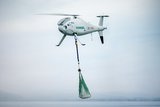Fire Scout completes second test period onboard USS McInerney
A Northrop Grumman Corporation-developed MQ-8B Fire Scout Vertical Takeoff and Landing Tactical Unmanned Aerial Vehicle (VTUAV) successfully completed fully autonomous flight operations onboard the USS McInerney (FFG-8) frigate.
These operations marked the first time that the Navy operated an autonomous VTUAV aboard a surface combatant vessel. This follows at-sea operations aboard the USS Nashville (LPD-13), which included the first autonomous ship landings by a US Navy Unmanned Aerial Vehicle (UAV).
This brings the Fire Scout program closer to Operational Evaluation (OpEval) status and eventually to operational status in the fleet. Test flights and OpEval on the USS McInerney are part of the Navy's risk reduction plan for the VTUAV program in anticipation of eventual test and deployment onboard a Littoral Combat Ship.
"The Fire Scout has demonstrated in the past the ability to provide intelligence, reconnaissance and surveillance support from a land-based ground control station. This shipboard operation marks a major milestone in Fire Scout's development cycle," said Capt. Tim Dunigan, Navy VTUAV Program Manager. "When at sea the most important attribute of a Naval aircraft is to integrate and function well within the shipboard environment and Fire Scout successfully demonstrated that."
The Fire Scout embarked aboard the guided-missile frigate USS McInerney, an Oliver Hazard Perry class frigate, while in port for operational fit checks and ship integration testing on Dec. 10, 2008. The Fire Scout is slated to deploy aboard USS McInerney during its next counter-narcotics trafficking deployment later this year.
This current test period completed initial shipboard landings, UAV Common Auto Recovery System (UCARS) wave-offs and expanded the rotor blade engage/disengage wind limits. The Fire Scout system equipment installation on USS McInerney was validated, and all components of the system were successfully tested. Shipboard testing will continue in early May.
"Our ultimate goal with the Fire Scout program is to provide the fleet with unprecedented situational awareness and precision targeting support," said Doug Fronius, MQ-8B Fire Scout VTUAV program director for Northrop Grumman's Aerospace Systems sector. "Deploying with the McInerney allows us the opportunity to showcase our commitment and dedication to bringing those capabilities to the U.S. Navy as we near OpEval."
More from Uncrewed Vehicles
-
Jammer resistant drone designs spark search for countermeasures
The Russia-Ukraine conflict has driven another stage of evolution for drones and the counter measures to defend against them.
-
![L3Harris launches Amorphous software for control of uncrewed platforms]()
L3Harris launches Amorphous software for control of uncrewed platforms
The new Amorphous software is a universal controller that would allow a single operator to control a swarm of “thousands” of uncrewed systems, from drones to underwater platforms.
-
ideaForge unveils new UAVs at Aero India 2025
India UAV supplier ideaForge has launched the Netra 5 and Switch V2 drones at Aero India 2025, boasting of enhanced endurance, AI-driven autonomy and improved operational capabilities.
-
![Shaping the future of defence: What 2025 holds for the global drone market]()
Shaping the future of defence: What 2025 holds for the global drone market
The UAV market is experiencing unprecedented growth, with innovations in technology and battlefield applications driving demand across military sectors. From the battlefields of Ukraine to NATO exercises and beyond, drones are transforming how wars are fought and supported.
-
![Maris-Tech confirms customers signing up for Jupiter Drones codec and AI-powered system]()
Maris-Tech confirms customers signing up for Jupiter Drones codec and AI-powered system
Launched at AUSA in October, the company’s multi-stream video codec is attempting to bring a new lease of life to drone technology through its AI accelerator.
-
![AUSA 2024: Quantum-Systems targets big 2025 with UAS developments]()
AUSA 2024: Quantum-Systems targets big 2025 with UAS developments
Quantum-Systems has been upgrading its UAS family, with new versions of the Vector, Reliant and Twister drones set for release throughout 2025.
























